A Designer’s Dream Garden
despite wildlife, water, and weeds
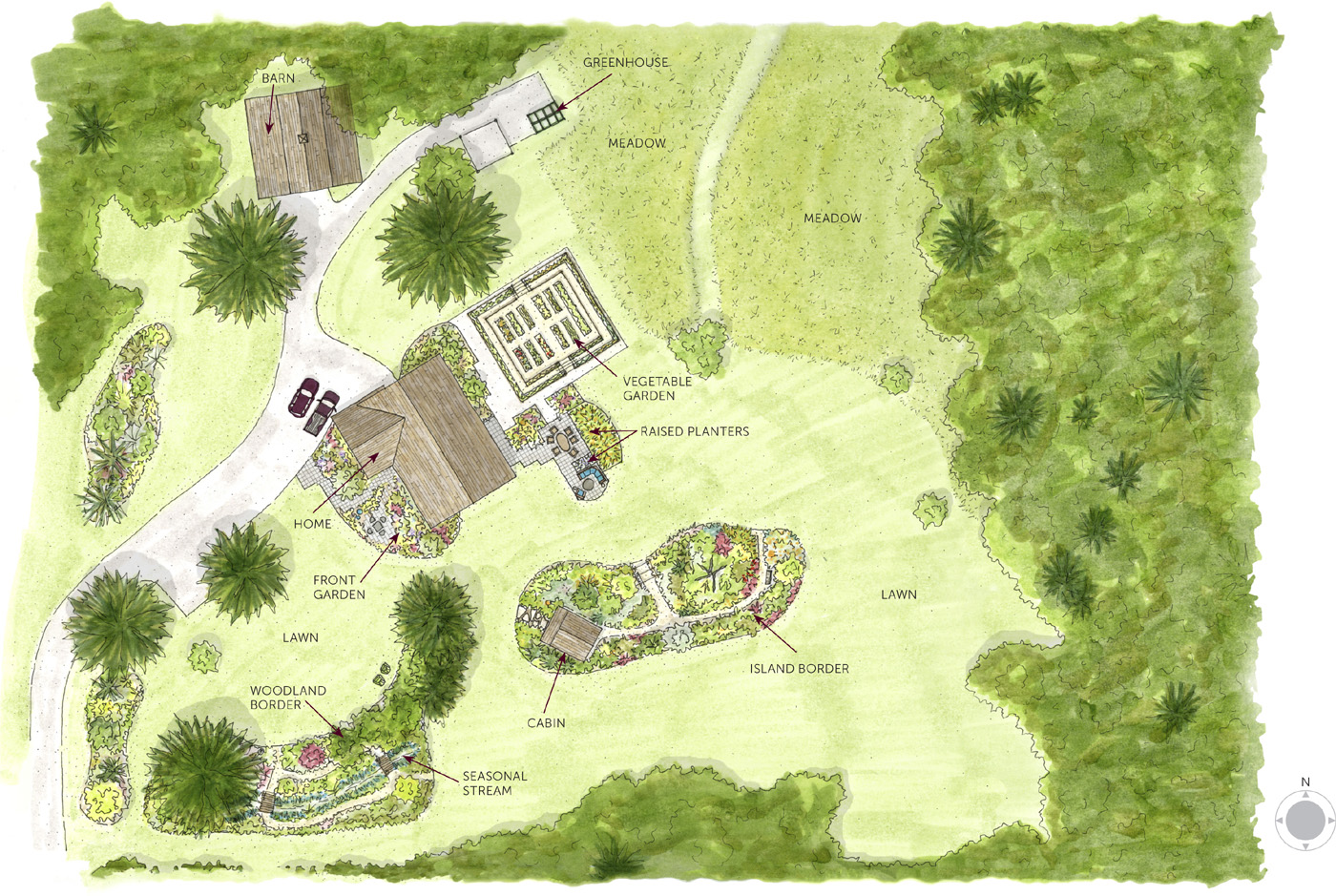
Design credits:
home of Andy and Karen Chapman
designed by Karen Chapman, Le Jardinet
Rising from a congested tangle of brambles, the dead maple tree struck an imposing silhouette against the sky. Some homeowners might find such a vision intimidating. To me it was the most promising feature in our new garden. “We just need to clear the weeds before we can start planting,” I remarked casually to my husband. Little did I know . . .
After months of searching, Andy and I believed we had finally found the perfect property in rural Duvall, thirty miles east of Seattle in the foothills of the Cascade Mountains. The modest single-story house and barn sat well back from the gravel road, surrounded by level pasture, a grassy meadow, and a forest of towering conifers interspersed with native shrubs whose names I was yet to learn. Swallows dipped and dived as we sauntered around the tranquil five acres on a perfect summer’s day, dreaming of how we would renovate the outdated home and transform the landscape into our private oasis. With Andy’s woodworking, engineering, and DIY skills and my horticultural and landscape design background, anything seemed possible. Teamwork, a sense of humor, and tenacity helped Andy and me hold true to the vision we formed that day.
We moved in on 30 October 2009, camping in our new home with only the essentials, storing most of our furniture and possessions in the barn while the builders set about the crucial rewiring, replumbing, and restructuring that were needed to make the dated home safe and secure. Those first six weeks were a series of daunting discoveries: a chorus of singing frogs in the crawl space (the bath tub drained directly onto the dirt floor beneath the house), dead mice in the walls (together with several pounds of birdseed), and electrical wiring that consisted of scraps of bare copper wire twisted loosely together to span the distance between receptacles and junction boxes. It’s a miracle the house was still standing. Nevertheless, our dry British humor and sense of adventure remained mostly intact—until it started to rain.
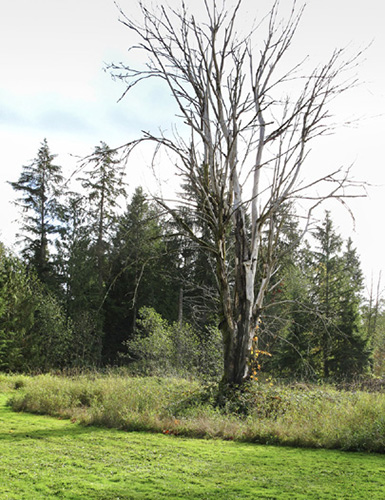
Inspiration for the location of a showcase border came from inauspicious beginnings—a dead bigleaf maple (Acer macrophyllum).
Fall was exceptionally wet that year, even for Seattle, and we watched with mounting dismay as our home became surrounded by a five-acre moat. That was my first clue that we had clay soil. My romantic dream of strolling through our idyllic country garden was swiftly replaced by the reality of squelching through muddy, ankle-deep pools that I knew would be teeming with man-eating mosquitoes come spring. How could I grow anything at all with the land virtually submerged for several months of the year? Bitter disappointment threatened to overwhelm me as I surveyed the disheartening scene, and I began to wonder if we had made a terrible mistake.
Thank goodness for friends. I was urged to seek the help of John Silvernale, an experienced landscape architect with Berg’s Landscaping, to see if the drainage problems could be corrected. Undaunted, he designed a network of 3-foot-deep French drains penetrating the sticky clay soil and inserted perforated pipes to carry excess ground water away, while enabling most of the rain to percolate into the surrounding soil. Finally, I could start to create my dream garden. I began planting in earnest in the spring of 2012, using Rutgers’ list of deer-resistant plants as my guide. Even though it was compiled with input from nursery and landscape professionals in northern New Jersey—a long way from Seattle—it seemed like a good place to start.
The previous homeowners had warned us that they saw two or three deer in the garden most days, but we didn’t see any until that fall, when seemingly overnight young conifers were ravaged, sedums were ruthlessly munched, and saplings suffered major bark wounds. I could have cried. I began to realize that plants being eaten was only part of the problem. I was witnessing significant damage by male deer rubbing their antlers and forehead against tree bark during rutting season. Where some gardeners might install tall fencing around their landscape to keep deer out, this wasn’t an option for us, due both to budget constraints and to the somewhat hazy property boundaries long since overgrown with woodland trees and brush. Knowing my luck, we would have fenced the deer in, along with the black bears, cougars, bobcats, and coyotes, all of which have since been seen. Meanwhile the rabbit population was exploding and seemed hellbent on eating the choice ornamental grasses and coneflowers, both of which had ironically been selected for their deer resistance.
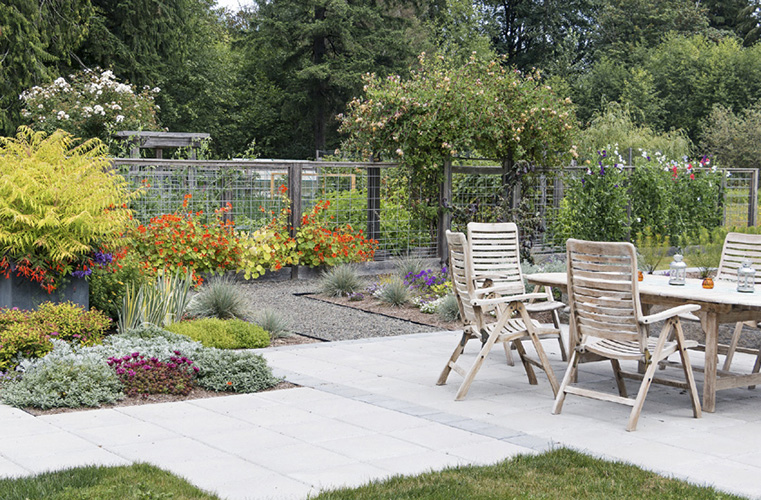
Casual dining is easy when the patio is close to the kitchen as well as the vegetable garden.
Sheer tenacity (my husband called it stubbornness) kept me going. I was determined to find solutions rather than throw up my hands in frustration. We learned to protect young trees with temporary livestock fencing and took note of which plants the deer usually ignored, or only minimally damaged, such as barberries, spireas, and weigelas, and planted more of them, seeking out varieties in other colors, sizes, and shapes for added interest. As for the rabbits, I thwarted those by selecting fast-growing, taller grasses such as miscanthus (Miscanthus sinensis) and switchgrass (Panicum virgatum) over the shorter, juicier, and apparently tastier sedges (Carex) and Japanese forest grass (Hakonechloa macra). I also found that by waiting until spring to cut these back, the winter-dried stubble protected the tender new blades from their inquisitive noses. I refused to be beaten.
By 2015 the garden was finally beginning to look established. Then the voles moved in. Unlike their insect-eating cousin the mole, voles are vegetarian and have a voracious appetite for roots and bulbs. Plant lists couldn’t help me this time—they ate anything and everything, and I began to lose mature trees as well as smaller shrubs and perennials to these pests. I researched various remedies, and we even adopted four barn cats, assured they would help. They didn’t. I swear our lot were vegetarian pacifists, doing little to keep the rodent population down, preferring to stretch out in a quiet, sunny spot and snooze the day away. In desperation, I even tried a Molecat, an eco-friendly device that kills burrowing rodents with a percussive blast; however, after one unfortunate mishap due to user error that left my ears ringing for hours, I still wasn’t any closer to a solution, and a large swath of yarrow (Achillea millefolium ‘Paprika’), usually a highlight of the summer garden, was on the verge of complete collapse. At this time, a gardening friend offered a tip that voles seem to be repelled by members of the spurge family (Euphorbiaceae). I dashed out, bought all the donkey tail spurge (Euphorbia myrsinites) I could find at the nursery, and surrounded the yarrow with them. Sure enough the voles kept their distance, their exploratory tunnels stopping 6 inches or so away from the enclave. Success! While the voles and I continue to draw new battle lines daily, I have begun to regain control of the garden through the judicious use of assorted spurges, daily tunnel-stomping, and sheer force of will.
Today several discrete garden rooms offer a variety of experiences, from a welcoming front garden in shades of silver and blue to a bold, showcase island border visible from multiple vantage points. The critter-proof vegetable garden is only steps away from a newly installed patio, providing an abundance of organically grown produce—mere minutes from garden to table. The patio works equally well for a party of twelve or two, drawing Andy and me out on mild evenings to watch the sun go down over a glass of wine.
Each distinct garden thread is woven together in a carefully designed tapestry. Key colors, shapes, and textures are repeated, creating a sense of unity and rhythm, while focal points help to anchor vignettes, strengthen sightlines, and ensure year-round interest. The garden has become an extension of our home as well as my business, hosting our daughter’s wedding, gardening events and workshops, magazine photo shoots, and even serving as the set for filming online video classes. The garden will never be perfect; something will always die, get eaten, or succumb to disease. But it’s our little piece of heaven on earth and for now at least the wildlife seems to have agreed upon a truce.
Island Border
As soon as I saw the sun-bleached bigleaf maple (Acer macrophyllum), I knew I had stumbled across the perfect focal point for a showstopping “Karen lives here” border. I drew inspiration from the Northwest Perennial Alliance Border at the Bellevue Botanical Garden, which features meandering paths that immerse visitors in the sights, sounds, smells, and textures of its abundant plantings; however, in lieu of a typical high-maintenance perennial garden, I wanted to focus on trees and shrubs, creating a rich tapestry of colorful foliage accented by just a few choice perennials, selected for their good manners and easy-going attitude. Another consideration: as with most homes in the area, our water comes from a private well. Far from being a reliable resource, this has the very real potential to run dry after prolonged summer droughts; therefore, it was important to select plants that would be drought tolerant once established.
With the weeds removed and French drains added, we were ready for the fun to begin. Renting oversized Tonka toys to move boulders and more than a hundred yards of topsoil saved time, energy, money, and possibly our marriage. Andy became quite the expert at maneuvering three-man rocks with a utility Bobcat, nudging them gently into place. Likewise, a skidsteer was key to moving an existing cedar-shingled cabin to a better location. I knew it would perfectly anchor one end of the new border, while visually balancing the upright form of the maple and creating a charming focal point, visible upon entering the property as well as being perfectly framed by a new picture window in the kitchen. Three men, a big machine, heavy-duty straps, and some choice words later, the cabin was where we wanted it, although the grass looked as though we had hosted the Nascar races for the weekend.
Andy and I designed and built a triple arbor, paying special attention to scale. A single archway would have appeared diminutive in such a wide-open space, yet we didn’t want a solid structure that would block views of the garden. An understated post and rebar design, each arch linked by a swag of marine rope, did the trick, giving dimension while maintaining transparency.
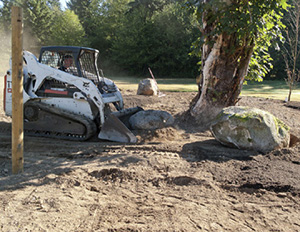
Maneuvering large boulders several hundred feet across a bumpy pasture was one thing. Doing so without losing the moss was another.
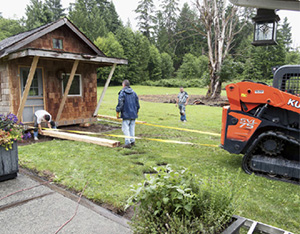
With the porch roof braced and the deck temporarily removed, the cabin was ready to be moved to its new location.
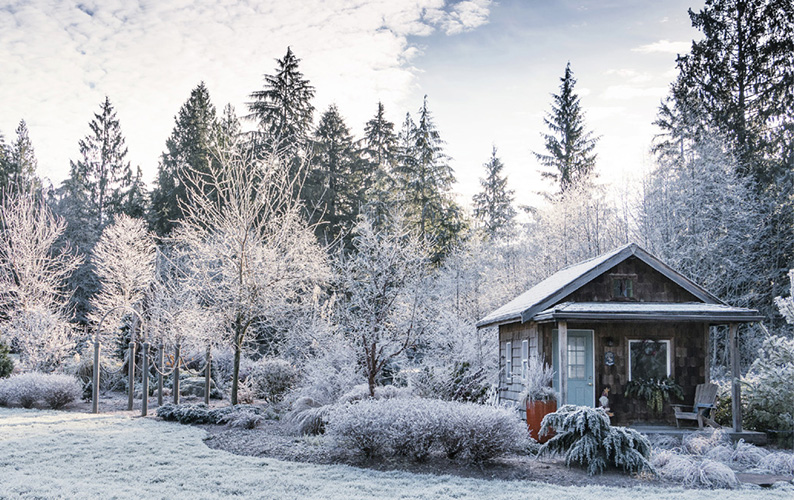
The arbor not only highlights the pathway leading into the island border, it also serves as a year-round focal point, especially dramatic in the skeletal winter garden.
With the cabin, boulders, arbor, and a simple path in place we began to plant evergreen and deciduous trees that provided height and color while giving the illusion of transitioning into the forest beyond when seen from a distance. With all my plant choices, I first considered what design attributes I was looking for (e.g., a fast-growing deciduous tree with golden foliage for full sun), then researched options both in my personal library of garden books as well as online, before finally cross-checking my shortlist against the anticipated level of deer resistance. In this instance, I selected golden locusts (Robinia pseudoacacia ‘Frisia’), which in this area do not sucker and have proven reliably deer-resistant thanks to their barbed branches. Other deciduous trees in this border include weeping willowleaf pear (Pyrus salicifolia ‘Pendula’), paperbark maple (Acer griseum), Himalayan birch (Betula utilis var. jacquemontii), and Persian ironwood (Parrotia persica ‘Ruby Vase’). The latter has since become a firm favorite with its spidery red winter flowers, interesting bark, and stunning range of foliage color, from green, gold, and orange to deepest purple and burgundy; it’s also more of an upright vase shape than the broad-spreading species. A variety of conifers contribute year-round color, from the rich green of Hinoki cypress (Chamaecyparis obtusa) through the blue tones of a deodar cedar (Cedrus deodara ‘Feelin’ Blue’) to the gold of an oriental spruce (Picea orientalis ‘Skylands’). A Port Orford cedar (C. lawsoniana ‘Wissel’s Saguaro’) is a columnar sentry, its cactus-like arms just begging to be hugged, while a white pine (Pinus strobus ‘Blue Shag’) offers a mound of teddy-bear softness. Color, texture, and personality—my sort of garden.
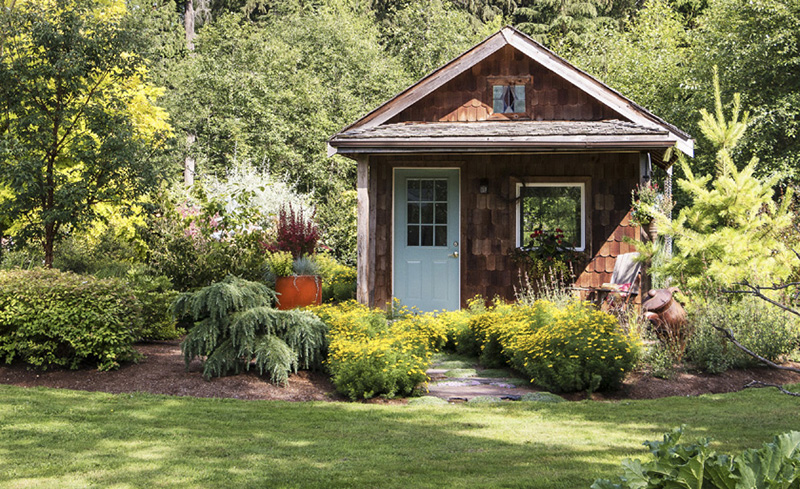
An informal flagstone path, softened with creeping thyme (Thymus serpyllum ‘Elfin’) and flanked by billowing tickseed (Coreopsis verticillata ‘Zagreb’) now leads to the cabin. The pale gray-blue of the door echoes the color of nearby foliage.

In winter, when the fleeting summer orange of the perennial crocosmias dies down, the colorful peeling bark of this paperbark maple (Acer griseum) will be clearly visible.
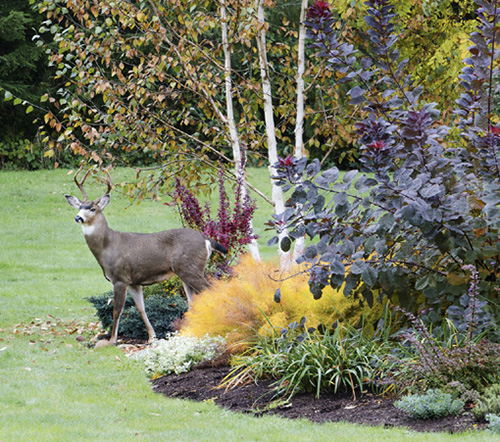
At least he used the path.
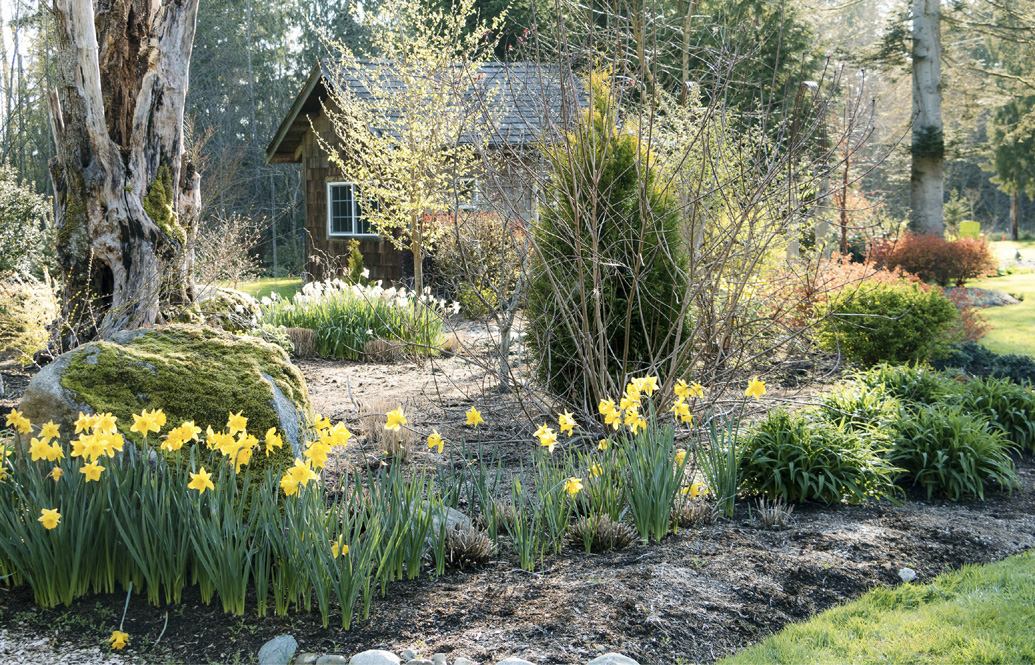
Golden Dutch Master and white Mount Hood daffodils are highlights of the early spring garden.
From there I layered in shrubs that offer multi-season interest, skipping those with plain green leaves, even if they also contributed summer flowers, in favor of those that offered a framework of colorful foliage. I opted for a sunset-inspired color scheme—warm shades of gold, orange, red, and even hot pink accented by purple and softened with blue-greens. These vibrant shades would be sure to make a statement whether viewed up close or from a great distance. Plus, it was fun, so why not? We managed to salvage several mature shrubs from the original front garden, including a treasured Exbury azalea with highly fragrant blooms the color of liquid gold, lichen-encrusted branches, and jewel-toned fall colors.
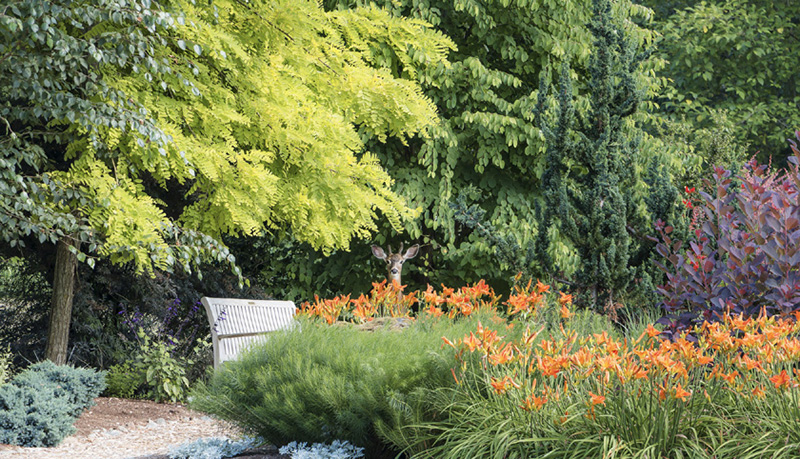
Although deer pass through this border daily, the damage done is minimal. While the newly emerging foliage of dozens of orange daylilies (Hemerocallis ‘Flasher’) are tempting in early spring, a quick spritz with a proprietary deer repellent seems to be enough to persuade them to do their taste-testing elsewhere.
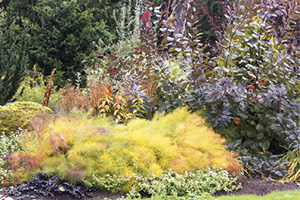
Strategically placed Arkansas blue star (Amsonia hubrichtii) is an autumnal star. The wispy foliage shifts through shades of gold, orange, burgundy, and purple, each kaleidoscopic variation more camera-worthy than the last when set against a purple smokebush.
After noting which path the deer took through this area, we planted a barrier of tall, thorny shrubs, including barberries (Berberis thunbergii ‘Rose Glow’), hollies (Ilex ‘Red Beauty’), and false hollies (Osmanthus heterophyllus ‘Goshiki’). This spiky barricade forced the deer to either stay on the path or find another way around, protecting more delicate plants from their careless hooves.
Yet this border needed to be more than just a collection of deer- and drought-tolerant plants, albeit combined with an eye for nuances of color, contrasting textures, and intriguing forms. It also needed to be appealing in every season. Today, hundreds of yellow and white daffodils (Narcissus) herald the arrival of spring, flanking paths and clustering at the base of mossy boulders.
By early summer spirea foliage glows, golden leaves highlighting the abundant pink flowers. I have the last laugh even if the deer decide to nibble some of these blooms, as the new growth is a rich coral-orange, which I love even more than the flowers. Blue-flowering catmint (Nepeta) and geraniums (Geranium ‘Rozanne’) and glaucous-leaved smokebushes (Cotinus coggygria ‘Old Fashioned’) help to temper the fiery barberries and crocosmia, while a burgundy Japanese maple (Acer palmatum ‘Fireglow’) and a purple smokebush strike a high contrast against neighboring golden conifers and a sweep of incendiary orange daylilies.
The cabin is highlighted by a late-summer meadow of golden black-eyed Susans (Rudbeckia fulgida var. sullivantii ‘Goldsturm’), the rich brown central cone of each daisy echoing the dark cedar shingles. As summer moves into fall I find myself frequently reaching for my camera to photograph the feathery Arkansas blue star (Amsonia hubrichtii) as it transitions through shades of copper and gold.
Meanwhile a katsura (Cercidiphyllum japonicum) exudes its distinctive scent of candy apples as the entire border embarks upon an autumnal display that lasts from September to late November. Even in winter this border is noteworthy, the bare tree branches and colorful bark, seed heads, grasses, and winter-hardy leaves etched with hoarfrost, highlighting their patterns and silhouettes. Like the rest of the garden this border is constantly evolving, but it has come a long way from its inauspicious beginnings.
Woodland Border
“Keep going!” I shouted, waving the driver of the excavator onward as he continued to carve out a drainage trench that led away from the island border toward a scruffy stand of cottonwood and alder saplings on the edge of the property. “Just wiggle a bit,” I added, hoping he would understand that I was asking for a natural-looking streambed rather than requesting he break out into some exotic dancing as he drove. Miraculously, he did, and after some more wiggling, we discovered water bubbling up out of the ground along this newly excavated trench, which explained in part why this previously undeveloped area was always so wet.
Until that moment I hadn’t given much thought to this part of the garden but suddenly I could envision a seasonal stream flanked by groves of deciduous trees, their canopies filtering the strong overhead sunshine to provide the perfect dappled conditions needed by the many shade-loving plants I had brought from our previous garden. This area would become a somewhat secluded, peaceful strolling garden that would provide respite from the intense summer sun. But first we had to remove countless beer cans, roadfill from a nearby construction site, and of course more weeds.
To prepare the ground for planting I had to tackle the reed canarygrass (Phalaris arundinacea), a highly invasive noxious weed I now know to be an indicator of very wet land. Spraying with herbicides was out of the question: there was a danger of contaminating the salmon spawning streams into which this newfound water would ultimately flow. Instead I layered cardboard, 4–6 inches of compost, and arborist chips, creating a weed-smothering sheet mulch that broke down over the course of a year, leaving in its wake a workable soil. A few pernicious clumps of the aggressive grass persisted, but I eventually won the battle. To make year-round access possible, Andy built two wooden bridges to traverse the stream, and I added a narrow circular path of wood chips.
Three ornamental pear trees that backed the original border were kept, as they offered height, maturity, and a sense of boundary between what was visible from the main garden and this new, private space. I supplemented them with river birch (Betula nigra ‘Heritage’), Himalayan birch, red maples (Acer rubrum), and columnar Swedish aspens (Populus tremula ‘Erecta’) for their seasonal water tolerance and bark interest, together with several golden locusts and a few smaller Japanese maples in the drier areas. This part of the garden is extremely wet during the winter, not only from the stream and perched water table but also from a pond on neighboring land that overflows into our garden. The extreme contrast between winter wet and summer dry made selecting plants for the woodland border very challenging. In addition, this area cannot be reached with a hose, and without a water source nearby, even hand watering wasn’t practical.
My aim was therefore to select plants that were appropriate aesthetically for a woodland yet were also able to cope with these less-than-perfect conditions as well as being both rabbit- and deer-resistant. I noticed that the deer seemed to have a regular route through the woodland, as some areas were browsed more heavily than others. I took advantage of this by placing plants that the deer seemed to reliably ignore—drooping fetterbush (Leucothoe fontanesiana ‘Rainbow’), hellebores (Helleborus), autumn ferns (Dryopteris erythrosora)—closest to their route and kept the temptations of my big, juicy hostas farther away. Having said that, the slugs can turn those hostas to lace in a matter of hours. There’s always something.
My quest for tough plants that met all these criteria has had mixed results. Oregon grape (Mahonia) hates wet winter soils yet seems to revive in spring. Twig dogwoods (Cornus) are not a shrub I would recommend for deer-prone gardens, as the new growth is always nibbled in spring, but since these shrubs thrive in wet soil and their winter color is so striking I couldn’t resist trying them. I planted mine under some tall red maples, fronted by low-growing sedges and ferns, none of which are of interest to passing deer, and so far they have gone unnoticed. Virginia sweetspires (Itea virginica ‘Little Henry’) are fabulous semi-evergreen shrubs in these challenging conditions; they thrive in areas with the wettest soil, which seems to hold enough moisture to get them through most summers, although they may defoliate in especially dry years. Their spring flowers may get nibbled but not enough (usually) to spoil the show, and the rosy color of the fall foliage alone is reason enough to add them to any garden. Astilbes on the other hand have not been successful—in summer the soil dries out too much for these moisture-loving perennials.
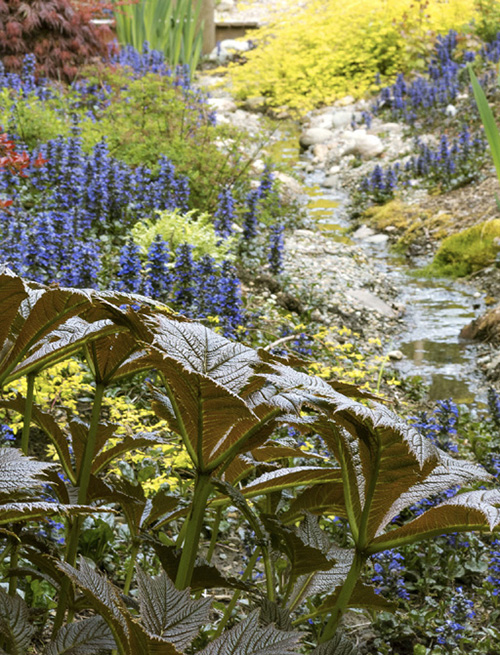
The streambed affords the moisture-loving Rodgers’ flower (Rodgersia podophylla ‘Rotlaub’) ideal growing conditions. Its leaves are a rich bronze as they emerge in spring, finally turning green.
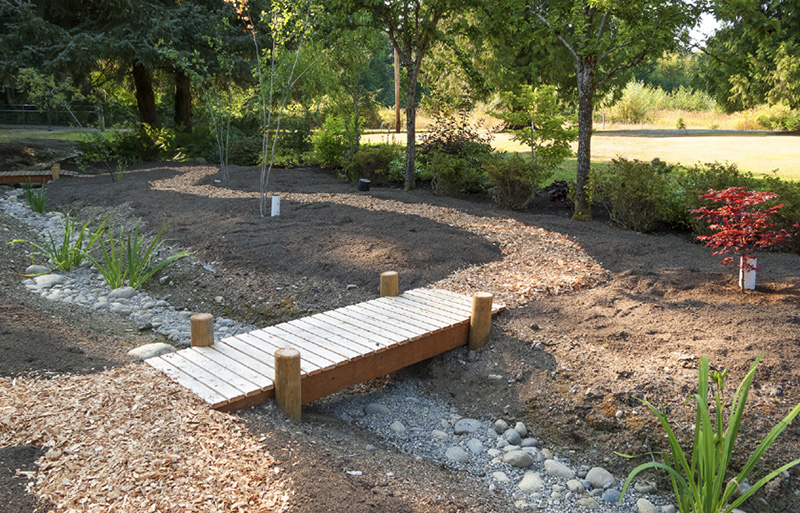
Two simple wooden bridges were constructed to span the seasonal stream that runs through the woodland.
The woodland border looks its best in spring when the cobalt-blue flowers of Catlin’s Giant bugleweed rise on short fat spikes above glossy black basal leaves; these line the streambank, amplifying the river effect. Bringing a little horticultural sunlight to the scene are several snowberries (Symphoricarpos ×chenaultii ‘Blade of Sun’) growing on either side of the bank; the small, bright yellow leaves on this ground-hugging layering shrub are truly delightful at this time of year. Elsewhere in the border, several varieties of bleeding heart (Lamprocapnos spectabilis) have their moment of glory together with some English primroses (Primula vulgaris) and cowslips (P. veris) that I have grown from seed.
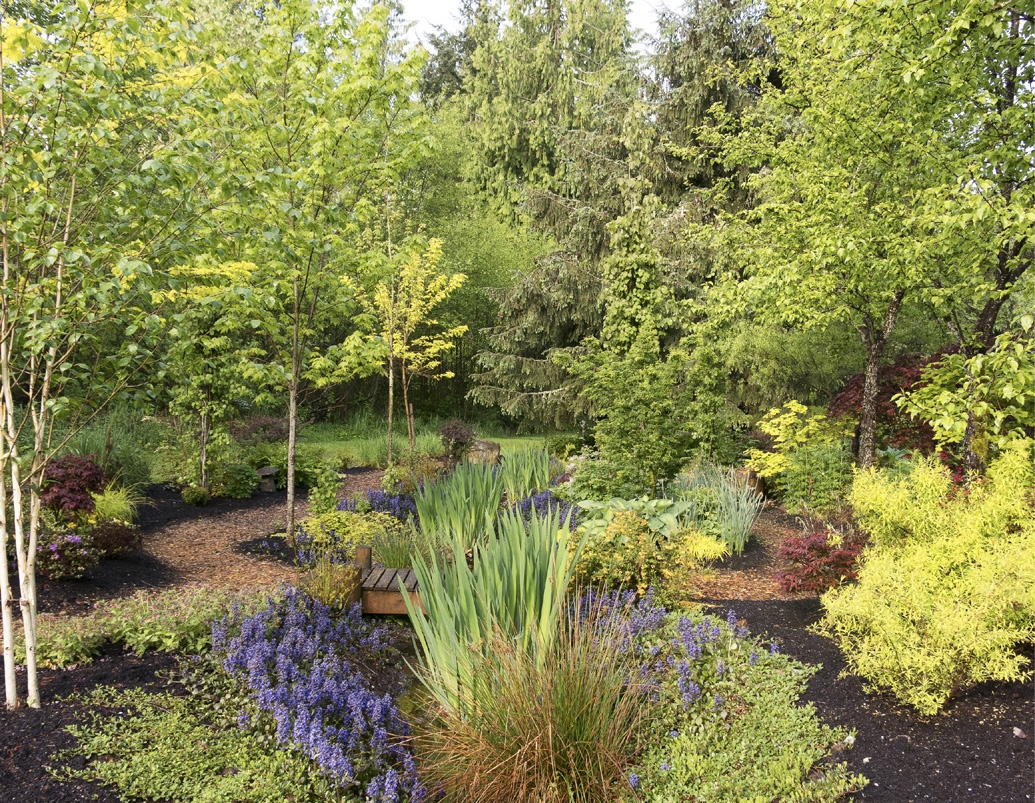
Layering creates an interesting woodland walk, the shrubs and perennials forming an understory to taller trees; bugleweed (Ajuga reptans ‘Catlin’s Giant’), bearberry cotoneaster (Cotoneaster dammeri), and other groundcovers control soil erosion on the streambanks.

Front to back: barberry (Berberis thunbergii ‘Red Carpet’), snowberry (Symphoricarpos ×chenaultii ‘Blade of Sun’), and bugleweed (Ajuga reptans ‘Catlin’s Giant’) mingle to create a colorful tapestry on the streambanks.
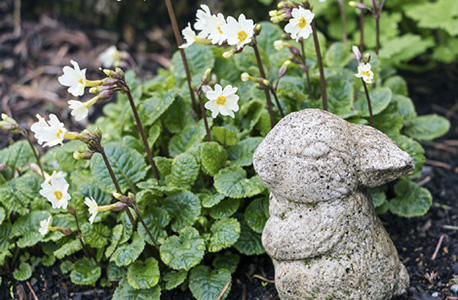
A cluster of primroses (Primula ‘Dorothy’) and a garden memento from our daughter’s childhood, waiting to be discovered by the next generation.
To truly appreciate the magical qualities of the woodland garden, one needs to explore through a child’s eyes. Diminutive stone statues and soft, mossy rocks are waiting to be discovered; fragrant English bluebells (Hyacinthoides non-scripta) become fairy hats in imaginative hands; posies of petite blooms can be picked for the table; tightly furled fiddleheads could be a tasty treat; the bridges invite a time-honored game of Pooh sticks with a friend. For those a little older but still children at heart, a stone bench invites quiet contemplation, while a whimsical collection of Three Blind Mice is sure to draw a smile. This is an enchanting place for those that take the time to look and to listen.
Front Garden
When we first viewed the house in the summer of 2009 a rampant wisteria dominated the front garden, all but obscuring the path, while the few shrubs and abundant perennials were completely engulfed by the attractive but highly invasive bishop’s weed (Aegopodium podagraria ‘Variegatum’) and a lifetime supply of mint. I knew straight away that virtually everything would have to go. Even though the plants were deer-resistant and mostly tolerant of drought, they were going to need far more time to manage than I was willing to invest, and this was also very much a summer-focused rather than a year-round design. Even the overall structure of the space wasn’t safe. As the position of the front door had been altered during the house remodel, the original path no longer lined up correctly. Likewise, when we converted a small garage to living space, the driveway design needed to be reconfigured.
Our vision was to create lush planting beds that would frame the home much as a traditional foundation planting plan might do, but additionally we decided to incorporate a small sitting area in the front garden and sweep the path in a much wider arc to make the approach to the front door feel more of a journey. A focal point was needed that would draw the eye and feet toward the home’s entrance. We used two sleek turquoise containers, converting the smaller one into a bubbling fountain and adding a stunning glass sculpture by Seattle artist Jesse Kelly to the larger vessel. Together they made the perfect statement, visible upon entering the property, when walking to the front door, or when viewing the garden from inside the home. They also helped to establish the color scheme for the front garden.
While both the woodland and island borders can be seen, at least in part, from the front garden, their physical distance makes it possible to have a different color palette in each area without the effect appearing too busy. The front garden is primarily blue, silver, and white with just a few accents of purple and chartreuse. These two accent colors can be found in the glass art as well as in all the other garden borders, so there is a subtle connection even as this space asserts its own identity.
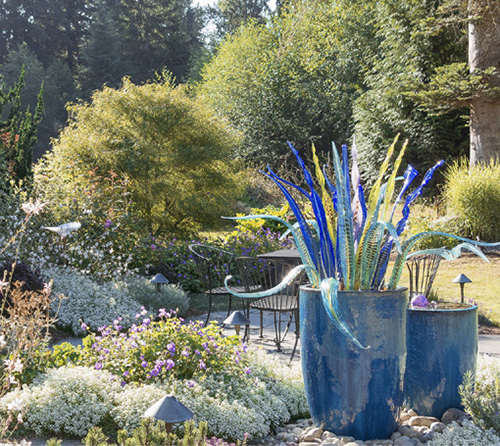
The color palette for the front garden was inspired by the dramatic glass sculpture and containers.
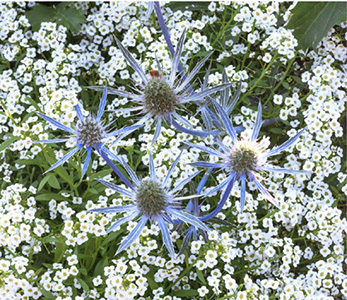
Sea holly (Eryngium ‘Sapphire Blue’) erupts from a carpet of fragrant sweet alyssum (Lobularia maritima). Both are remarkably tolerant of drought, as well as being both rabbit- and deer-resistant.

Backlit by the sun, the thread-like foliage of a Japanese maple (Acer palmatum ‘Koto-no-ito’) appears to glow.
It took almost two years to dig out every last piece of those aggressive weeds, but it was worth the time and effort. Now the summer display includes mounding barberries (Berberis thunbergii ‘Concorde’), their rich purple foliage enhancing the superbly floriferous blue Rozanne geraniums and delicate wands of gaura (Gaura lindheimeri ‘Whirling Butterflies’) that appear to dance in the slightest breeze from late spring through fall. All are backed by Magical Fantasy weigela (Weigela florida ‘Magical Fantasy’), a delightful cultivar with crisp white and green variegated foliage, as well as other five-star flowering shrubs including a golden-leaved dwarf bluebeard (Caryopteris ×clandonensis ‘Lil’ Miss Sunshine’) and a beautiful variegated rose of Sharon with ruffled lavender blooms (Hibiscus syriacus ‘Summer Ruffle’). I often add sweet alyssum (Lobularia maritima) to edge the paths and borders, its honey-like scent perfuming the air. As well as being deer-resistant and remarkably drought tolerant, the flowers attract many different pollinators, their gentle humming adding to the sounds of summer.
Although the front garden display starts to wind down in fall, one highlight is a specimen Koto-no-ito Japanese maple (Acer palmatum ‘Koto-no-ito’). The name translates to “harp strings,” appropriate for the delicate, thread-like leaves that turn astounding shades of gold and copper as autumn progresses.
A variegated Canadian hemlock (Tsuga canadensis ‘Gentsch White’), pruned each spring to promote the brightest color, junipers (Juniperus squamata ‘Blue Star’), and dwarf pines ensure plenty of winter interest, while the pristine white bark of a Himalayan birch creates drama, especially when uplit at night. It seems no time at all before the garden awakens again in spring with daffodils, English bluebells, purple ornamental onions (Allium), luscious peonies, and the heady perfume of old-fashioned Cheddar pinks (Dianthus gratianopolitanus ‘Firewitch’).
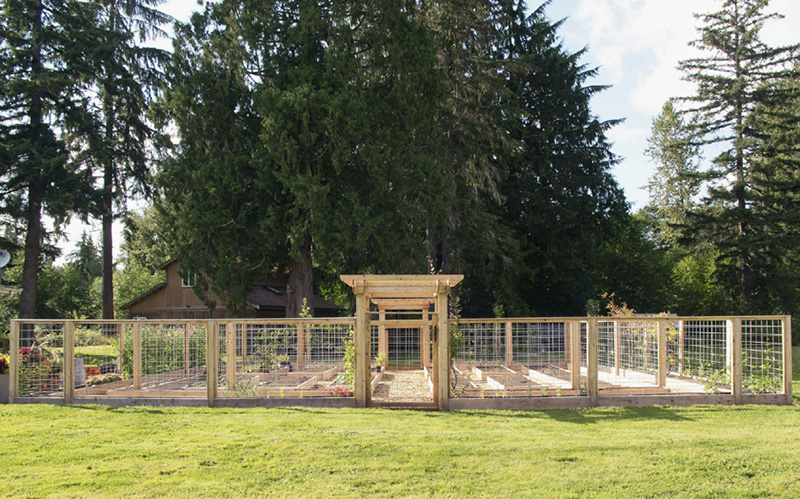
The vegetable garden features a double fence to keep deer out. To date, the tactic has worked, and we have yet to discover any confused deer wandering within it.
While deer do investigate this garden, their visits are primarily confined to winter months when they do little damage other than standing on emerging bulbs. I have even successfully grown two roses in this area, although I do spritz them with repellent when in full bud as a precaution. Regardless, this newly designed space welcomes friends and family, offering an intimate setting in which to sit and listen to the sounds of the garden—the gentle bubbling of a fountain, the distinctive whir of a hummingbird’s wings, and the lazy droning of hundreds of honey bees enjoying the garden as much as we do.
Vegetable Garden
It began with the War of the Parsnips. Our family loves these roasted root vegetables for Thanksgiving dinner as well as in hearty winter soups and casseroles, so I was excited that our new home had an existing fenced area suitable for growing them. So were the voles. They completely decimated my crop that first year, eating every single delicious root and leaving me only the leafy tops. I was not impressed. Thus began the War of the Parsnips and a complete redesign of our vegetable garden in order to keep out deer and rabbits as well as those pesky burrowing rodents. However, being close to the house and highly visible, the structure needed to be attractive as well as functional.
At 40 feet by 45 feet, the new plot exceeded the square footage of the house, so surrounding it with a traditional 8- to 10-foot-tall deer fence would have given the impression of a fortress and completely overwhelmed our single-story home. We opted instead for two 5-foot-high fences spaced 5 feet apart, with 8-foot-tall pergolas, planted with vines, at the two entrance gates. The principle is that deer won’t jump when they can’t see what is on the other side, and although they could easily clear one fence, they can’t land safely between the two, or jump both at the same time. We used panels of galvanized hog wire with graduated openings for the fencing; the smaller size at the base keeps the rabbits out, and the deer can’t get their muzzles through the larger gaps at the top. Conveniently, the panels also serve as ideal structures on which to grow sweet peas or as a framework for espaliered fruit trees.
That took care of the rabbits and deer, but we still had the troublesome voles to deal with. We sunk quarter-inch galvanized mesh hardware cloth 3 feet deep around the perimeter of the vegetable garden, attaching it to 10-inch-high boards installed at the base of each fence section. Voles can’t get through such small mesh, and we didn’t think they could scale the vertical 10-inch boards—but sadly we were wrong on the latter account. If we were to do this again, we would use 18-inch vertical base boards. However, a combination of 12-inch-high raised beds for the vegetables together with entry being harder to gain for all but the most athletic of those sneaky little pests means we have enjoyed lots of parsnips ever since, and the voles have gone hungry.
I have to confess that none of this was cheap. You might well say, “Karen, there are perfectly good stores where you can buy parsnips.” I know. But where’s the fun in that?
Top 10 Plants
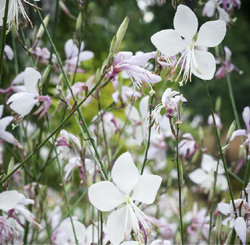
Whirling Butterflies gaura (Gaura lindheimeri ‘Whirling Butterflies’). Delicate wands of pink-suffused white flowers dance above the foliage from late spring through fall. In colder areas this drought-tolerant, deer-resistant perennial may die back to the ground in winter, so avoid cutting back old stems until spring. In warmer climates, it may remain a woody shrub and self-seed. Grows 3 feet tall and wide. Full sun, zones 5–9. Deer resistance: A.
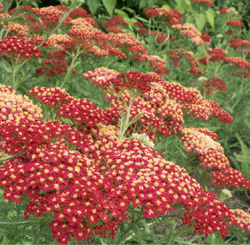
Paprika yarrow (Achillea millefolium ‘Paprika’). Feathery, aromatic gray-green foliage is the perfect foil for the abundant summer blooms that open bright crimson and transition through shades of pink and terracotta before fading to tan. Deadheading at this stage will encourage a second wave of flowers. Reliably drought tolerant. Grows 2 feet tall, 3 feet wide. Cut this herbaceous perennial back in late fall or early spring. Full sun, zones 3–9. Deer resistance: B.
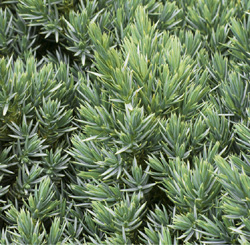
Blue Star juniper (Juniperus squamata ‘Blue Star’). A low-growing blue-gray conifer, 2 feet tall, 3–4 feet wide, with short, stiff branches and spiky needles. Ideal for containers or the landscape. Full sun, zones 4–8. Deer resistance: B.
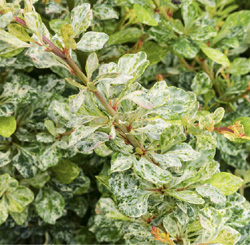
Lime Glow barberry (Berberis thunbergii ‘Lime Glow’). A thorny, deciduous shrub, 4 feet tall and wide, with marbled lime-green and creamy white foliage that turns vivid shades of crimson in fall. Prune by a third in spring to encourage the colorful new growth. Full sun, zones 4–8. Deer resistance: A.
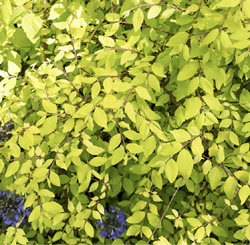
Blade of Sun snowberry (Symphoricarpos ×chenaultii ‘Blade of Sun’). An outstanding deciduous groundcover for a woodland garden with wide-spreading branches that form dense layers of golden foliage. Emerging brilliant yellow, the color fades to chartreuse in deeper shade, returning to gold in fall, when small pink berries add to the scene. Grows 1–2 feet tall, 3 feet wide. Partial shade, zones 4–9. Deer resistance: B.
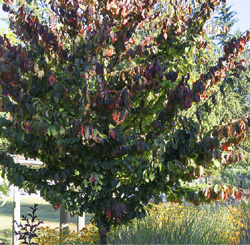
Ruby Vase Persian ironwood (Parrotia persica ‘Ruby Vase’). Interesting bark, winter flowers, multi-toned foliage, and stunning fall color—this slender tree deserves a place in every full sun–partial shade garden, eventually reaching 30 feet tall, 12 feet wide. Emerging leaves on lower branches may be nibbled in spring. Zones 5–7. Deer resistance: B.
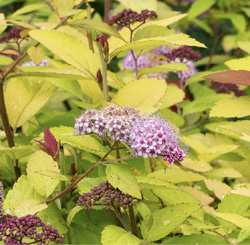
Double Play Gold spirea (Spiraea japonica ‘Double Play Gold’). Emerging spring foliage is copper, maturing to gold in summer, when the entire shrub is covered with hot pink flowers that attract bees, butterflies, and the occasional deer. The floral display is so abundant that the few deer-pruned blooms won’t be missed, and the new flush of foliage color more than makes up for the minor damage. Grows 3–4 feet tall and wide. Full sun–partial sun, zones 4–9. Deer resistance: B.
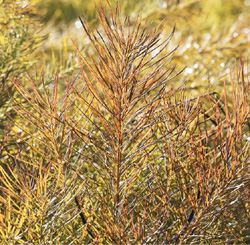
Arkansas blue star (Amsonia hubrichtii). Early spring flowers are blue, but this perennial is all about the feathery green foliage, which turns shades of orange in fall. Grows 2 feet tall and wide; extremely drought tolerant. Full sun, zones 5–8. Deer resistance: A.
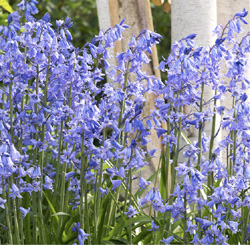
English bluebells (Hyacinthoides non-scripta). Unlike their invasive Spanish cousins, English bluebells are well behaved and do not spread aggressively but rather naturalize slowly, forming carpets of fragrant spring blooms, 1.5 feet tall. Plant bulbs in fall. Full sun–partial shade, zones 5–8. Deer resistance: B.
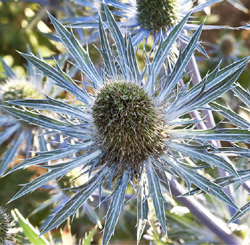
Sapphire Blue sea holly (Eryngium ‘Sapphire Blue’). One of the bluest sea hollies, the spiky bracts of this herbaceous perennial make a bold statement in the summer garden. Grows 2.5 feet tall, 1.5 feet wide. A favorite of flower arrangers, bees, and butterflies but mercifully completely ignored by deer and rabbits in my garden, although Rutgers lists the genus as being frequently severely damaged. Full sun, zones 4–8. Deer resistance: D.